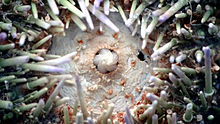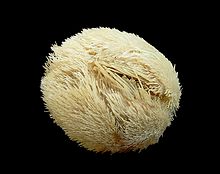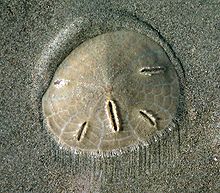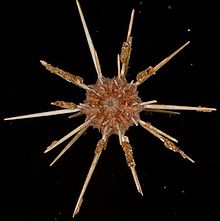sea urchin
| sea urchin | ||||||||||||
|---|---|---|---|---|---|---|---|---|---|---|---|---|

The two regular sea urchins Tripneustes ventricosus (above) and Echinometra viridis (below) in a reef |
||||||||||||
| Systematics | ||||||||||||
|
||||||||||||
| Scientific name | ||||||||||||
| Echinoidea | ||||||||||||
| Leske , 1778 |
The sea urchins (Echinoidea) ( ancient Greek ἐχῖνος echinos " hedgehogs ") form one of the classes that belong to the echinoderm tribe . There are in all seas living, invertebrate animals . The class is divided into 14 orders . About 950 species are known to date . They have been populating the earth for around 480 million years.
construction

skeleton
"Casing"
The skeleton of sea urchins consists of calcium carbonate ("carbonate of lime", CaCO 3 ) in the modification calcite . The part of the skeleton that protects the inner soft tissues is often referred to as the "shell" or "shell", but unlike the calcareous shell of snails or the valves of mussels , this shell lies beneath the thin epidermis . Therefore, in contrast to the shells and shells of most other invertebrates , it is a calcareous inner skeleton .
The housing of the regular sea urchins ("Regularia"), which have the typical long-spiky shapes, is characterized by a regular five-fold (pentameric) radial symmetry . Depending on the species, it can be almost spherical or clearly flattened ellipsoidally . It essentially consists of 5 double rows of ambulacral plates (Ambulacralia) and 5 double rows of interambulacral plates (Interambulacralia). The individual housing plates, which are calcite single crystals , each have the shape of irregular pentagons or hexagons . The ambulacral plates are smaller than the interambulacral plates and contain small holes (ambulacral pores) through which the inner parts of the ambulacral feet pass. Both ambulacral and interambulacral plates have round joint cusps ("warts") that serve as bearings for the spines.

The forms grouped under the name of irregular sea urchins, which include the sand dollars and the heart urchins , differ significantly from the regular sea urchins. Their skeleton is often flattened (especially extreme in the case of the sand dollars) and not radially symmetrical, but bilaterally symmetrical , although the original pentamerism can still be seen. With these representatives there is therefore a front and a back as well as a left and right, and the movement always takes place with a forward tendency. Spines are greatly reduced in size, but not in number, so that the spines are reminiscent of a coat of hair. These differences in physique arose as an adaptation to a digging way of life.
Spines
The spines of the sea urchins are also made of calcite and are mostly also located below the epidermis. They sit on small joint bumps and muscles can move them in all directions. The formation of the spines, their size, function, etc. can be very different depending on the type. A distinction is made between three main types of regular sea urchins, and ten to twelve of the irregular ones. The spines are mainly used to protect against predators such as starfish , large snails and fish and can even give off poison in some species when stinging ; The leather sea urchins (fire sea urchins ) are particularly poisonous . There are sea urchins that dig into hard substrates such as coral reefs and rocks with their spines . In many irregular sea urchins, food is driven by the spines. Residents of soft soils also use their spines to move.
If a person steps on a sting, it may break off and get stuck in the foot, which can lead to painful purulent inflammation. In addition, the spines of some species are difficult to remove.
Pedicellariums
Pedicellariums are small, pincer-shaped appendages that have evolved from spines. Their function is to clean the surface of the sea urchin and remove parasites . Some of the pedicellariums have venom glands.
Periproct (and peristome)
In sea urchins, the area around the anus opening is made up of several irregularly arranged limestone plates and is called the anal field or periproct . In the case of the radially symmetrical regular sea urchins, the anal field is located centrally on the top of the housing, opposite the mouth opening (peristome), which is centrally located on the bottom.
In the bilaterally symmetrical irregular sea urchins, however, the periproct marks the rear end of the housing. Most of the time it faces straight back, but with some shapes it is even in the rear area of the underside of the case. In irregular sea urchins, the peristome is not centrally located on the underside, but is offset forward.
Oral apparatus
To chop up their food such as seaweed or carrion , the regular sea urchins have a special, complexly structured jaw apparatus with calcitic hard parts, the lantern of Aristotle . In the irregular sea urchins this jaw apparatus is either partially or completely reduced.
Ambulacral system
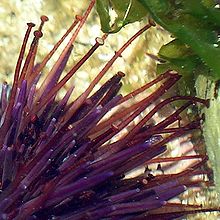
The interior of the sea urchin is divided by a series of tubular, fluid-filled cavities - the ambulacral system . All sea urchins (and also starfish) have in common the ambulacral feet, thin tube-like appendages, the inner parts of which are protuberances of the ambulacral system and the outer parts of which are protuberances of the epidermis. They can be moved by changing the pressure of the fluid contained in the inner parts (hemolymph), usually end in a small epidermal suction disk and are used, among other things, for locomotion, attachment to the ground or for transporting food particles to the mouth.
Predators
Some starfish belong to the predators of the sea urchins. Since the species Pycnopodia helianthoides (sunflower starfish) is currently affected by mass extinction due to the overheating of its habitat as part of climate change and a virus, sea urchins are losing an important predator and are spreading explosively in places, which in turn affects the populations of Seaweed , which is a food source for sea urchins.
Reproduction
The sea urchins are separate sexes. Egg and sperm cells are released into the water in large quantities. The planktonically living, bilaterally symmetrical secondary larvae of the sea urchins are called plutei (singular pluteus ). In sea urchins off Elba in the Mediterranean Sea , the formation of reproductive groups was observed at a depth of approx. 40 m. Several (10–30) individuals come together in one place, most of them so close that they touch with their spines. In these groups, egg and sperm cells are then released from many animals at the same time, thus significantly increasing the probability of successful fertilization.
Systematics
- Subclass: Perischoechinoidea
- Subclass: Cidaroidea
- Order: Lance Sea Urchin (Cidaroida)
- Family: Cidaridae
- Family: Psychocidaridae
- Order: Lance Sea Urchin (Cidaroida)
- Subclass: Euechinoidea
- Order: leather urchin or fire urchin (Echinothurioida)
- Family: Echinothuriidae
- Family: Kamptosomatidae
- Family: Phormosomatidae
- Order: Micropygoida
- Family: Micropygidae
- Order: Aspidodiadematoida
- Family: Aspidodiadematidae
- Order: Diadematoida
- Family: Diadematidae
- Order: Pedinoida
- Family: Pedinidae
- Superordinate: Echinacea
- Order: Arbacioida
- Family: Arbaciidae
- Order: Real sea urchins (Echinoida)
- Family: Echinidae
- Family: Echinometridae
- Family: Parasaleniidae
- Family: Strongylocentrotidae
- Order: Temnopleuroida
- Family: Temnopleuridae
- Family: Toxopneustidae
- Order: Arbacioida
- Superordinate: Calycina
- Order: Salenioida
- Family: Saleniidae
- Order: Phymosomatoida
- Family: Phymosomatidae
- Family: Stomechinidae
- Order: Salenioida
- Order: leather urchin or fire urchin (Echinothurioida)
- Infraclass: Irregularia
- Order: Holectypoida †
- Order: Echinoneoida
- Family: Echinoneidae
- Superorder: Neognathostomata
- Order: Cassiduloida
- Family: Apatopygidae
- Family: Cassidulidae
- Family: Echinolampadidae
- Family: Neolampadidae
- Family: Pliolampadidae
- Order: Sand dollars (Clypeasteroida)
- Family: Arachnoididae
- Family: Clypeasteridae
- Family: Fibulariidae
- Family: Laganidae
- Family: Rotulidae
- Family: Astriclypeidae
- Family: Dendrasteridae
- Family: Echinarachniidae
- Family: Mellitidae
- Order: Cassiduloida
- Superorder: atelostomata
- Order: Holasteroida
- Family: Calymnidae
- Family: Holasteridae
- Family: Pourtalesiidae
- Family: Urechinidae
- Order: Heart Sea Urchin (Spatangoida)
- Family: Asterostomatidae
- Family: Aeropsidae
- Family: Hemiasteridae
- Family: Pericosmidae
- Family: Schizasteridae
- Family: Brissidae
- Family: Loveniidae
- Family: Spatangidae
- Family: Toxasteridae
- Order: Holasteroida
use
In southern France , southern Italy , Greece , Morocco , Chile and Korea, as well as numerous other countries, the five sex glands of the sea urchins, raw or cooked in salt water, are particularly popular as starters . In Japanese cuisine, sea urchin eggs can be found on the menu under the name “ Uni ” and are used in various dishes.
Individual evidence
- ↑ The sea urchin - profile on biologie-schule.de
- ^ W. Westheide and R. Rieger: Special Zoology Part 1 , p. 328, ISBN 3-437-20515-3 .
- ↑ Smith, Andrew B .: Echinoid palaeobiology . Allen & Unwin, London 1984.
- ↑ Keyword “Periprokt.” In: Herder-Lexikon der Biologie. Spektrum Akademischer Verlag GmbH, Heidelberg 2003, ISBN 3-8274-0354-5 .
- ↑ CD Harvell et al. a. (2019). Disease epidemic and a marine heat wave are associated with the continental-scale collapse of a pivotal predator (Pycnopodia helianthoides). Science Advances , 5 (1), eaau7042. https://doi.org/10.1126/sciadv.aau7042
Web links
- Sea urchins at the National Center for Biotechnology Information (NCBI)
- Integrated Taxonomic Information System Echinoidea Leske, 1778
- Dr. Andrew B. Smith, The Natural History Museum, London The Echinoid Directory

